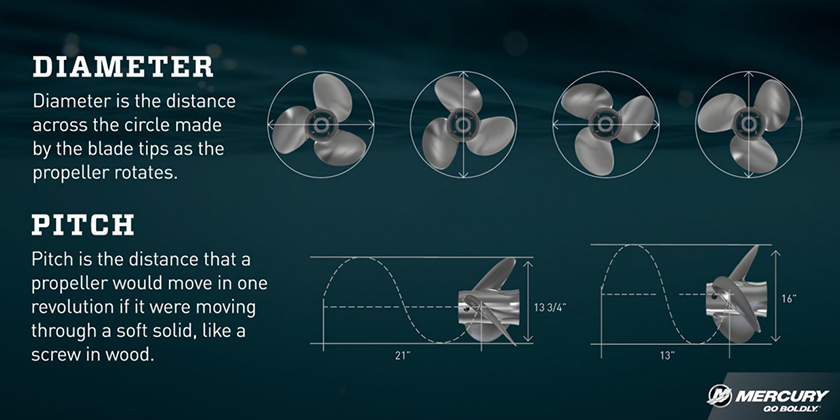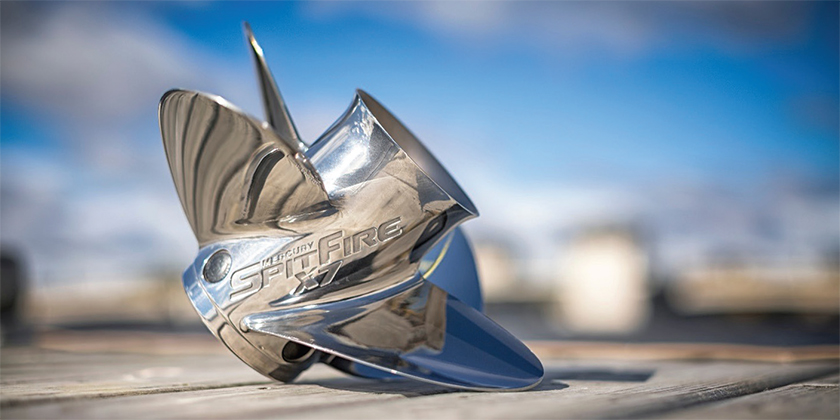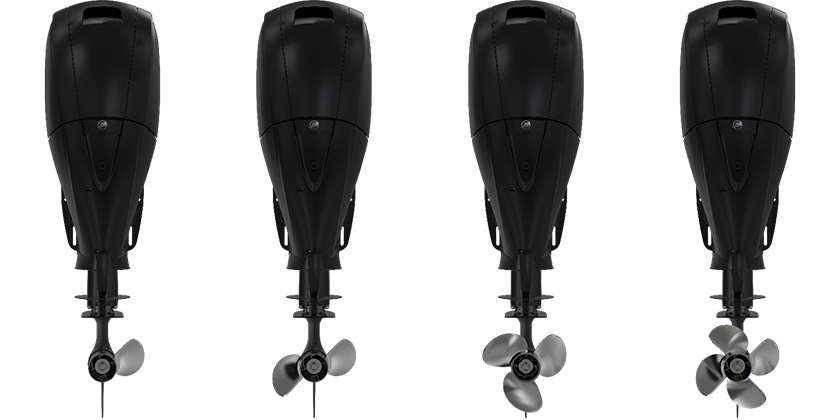So, You Need a New Prop

Re-Propping your boat: Is it science or an educated guess?
By Art Bates, Mercury Marine, Technical Account Manager & Master Technician
all images Credit: Mercury Marine
To answer the question in the topic line, yes and yes, however, I would prefer to call it a “well-educated” guess.
Being asked to contribute to an article on re-propping at this particular time was appropriate because, during a recent conversion with some colleagues, we were discussing what the most common inquiries were that we received from customers while working the boat shows, everyone agreed that propellers and re-propping was at or near the top of the list.
Given the frequency of the question “What is the best prop for my boat?”, it would be beneficial to explore the details of why this question is asked so often and the information that is required to answer the question most accurately. Let’s investigate!
Some reasons that someone might want to re-prop their boat/engine package might be as follows:
- A boat may have been repowered with a new engine that is a different horsepower than the original package.
- Improving or optimizing hole shot (time to plane)
- Improving or optimizing acceleration and midrange power
- Improving or optimizing cruise rpm range and fuel economy,
- Improving or optimizing top-speed performance
You might have noticed that the terms Improving or optimizing were used, this is because life is full of compromises, propping just happens to be one of those situations that falls into the category of “you can’t have your cake and eat it too” For example, you can not optimize top end speed without suffering reduced hole shot and acceleration performance and vice versa.
Why can’t I have the best of both worlds? you might ask. The answer is math and physics.
Please don’t stress with visions of formulas and equations on the chalkboard and move on to the next article. We are about to clear this up for you in a quick and painless manner.
First, we need to discuss common prop terminology that is used to identify the dimensions and characteristics of a propeller.
Mercury Marine discusses more about propeller characteristics in their online Prop Bites series which are referenced in these next few paragraphs.
At its most basic, a boat propeller is simply a screw turning through the water. To better understand how that screw works, let’s define the two key dimensions used to describe all props: diameter and pitch.

For more information on PITCH & DIAMETER; Click Here
Diameter
Propeller diameter is easy to understand – it’s simply the diameter of the circle scribed by the blade tips as the prop rotates. Imagine attaching a pencil to the tip of one blade and then turning the prop over a sheet of paper. That would trace a circle representing the propeller’s circumference; the diameter of that circle is the length of a straight line traversing the widest point of that circle.
Propeller engineers determine the prop diameter based on the RPM at which the prop will be turning and the amount of power delivered to the prop. Diameter usually increases for propellers used on slower and heavier boats, and decreases for propellers intended for faster boats. A prop with more diameter has more total blade area, which allows it to handle more power and create more thrust to move a heavy boat. More blade area gives the engine more “traction,” like a set of aggressive truck tires. But just like those tires, that added prop diameter also creates more drag, which is compounded as boat speed increases.
Pitch
Propeller pitch is usually described as the theoretical distance in inches a prop would move in one revolution through a soft solid. Think about turning a screw into wood, or a corkscrew into a wine bottle cork. Our 14 x 19 prop will thus move 19” forward with each revolution. A 14 x 21 prop would move 21” with each revolution, and so is doing more work – and moving faster – than the 19-pitch prop at the same RPM. Some Mercury propeller models are offered in one-inch pitch increments, while others come in two-inch increments.
Changing propeller pitch is rather like changing gears up or down on a bicycle – in low gear, you can accelerate quickly from a standing start, but soon your legs will be spinning and you won’t go very fast. In high gear, you’ll need to mash the pedals to start moving but you’ll eventually reach a faster top speed. All else being equal, adding propeller pitch will decrease wide-open throttle (WOT) engine speed, while subtracting pitch will increase WOT RPM. If prop pitch is too low, engine RPM at wide-open throttle may be too high (above the engine’s recommended WOT RPM range) and, while boat acceleration may be strong, top speed will suffer. If the prop pitch is too high, acceleration will suffer and the engine will “lug” or not be able to reach the bottom of the recommended WOT RPM range. Either condition – WOT RPM that is too high or too low – can damage the engine and drive components.
Slip
Because it sounds like a negative, “slip” might be the most misunderstood of all propeller terms. But slip is actually essential to propeller function.

For more information on PROP SLIP, Click Here.
Propeller slip is the difference between the actual distance the prop travels forward through the water versus the distance it should theoretically travel based on the prop blades’ angle of attack. The theoretical travel is determined by the prop pitch. A prop with a 21-inch pitch, for example, would travel 21 inches with one revolution through a soft solid. Think about a screw turning into a piece of wood. However, in the real world and in real water, the propeller does not act like a screw turning through wood. There will be a certain amount of slip, which is actually necessary.
This sounds inefficient. It seems that zero slip would certainly be ideal. However, slip is not a measure of propeller efficiency, and without some slip, the prop could not move the boat forward at all.
To understand why, let’s back up and define the term “angle of attack.” One way to understand angle of attack is to think about an airplane wing. If that wing is a symmetrical airfoil moving through the air horizontally – a zero-degree angle of attack – air will pass symmetrically above and below the wing, resulting in equal pressure above and below the wing. No lift is generated to carry the weight of the plane. If we add some angle of attack by tilting the leading edge of the wing up, lift is generated. There will be negative pressure above the wing and positive pressure below the wing. You can experience the same effect by holding your hand out the window of a moving car. If you tilt your hand up, you feel lift.
The function of a boat propeller blade is like that of the airplane wing. If the propeller blade has no angle of attack, there is no slip, but also no positive or negative pressure around the blades. Propeller blades with some angle of attack create negative (lower or pulling) pressure on one side of the blade and positive (higher or pushing) pressure on the other side of the blade. The pressure difference creates lift at right angles to the blade surface, which both lifts the boat and thrusts it forward.

That angle of attack also results in some slip. Without some slip, there’s no thrust. Creating the desired range of slip is one of the key challenges facing a propeller engineer, and there are a number of ways this can be accomplished within all of the other design parameters (blade diameter, blade shape and area, blade rake and cup) the engineer needs to consider.
Calculating slip can be useful when diagnosing an issue with a setup. Calculated propeller slip within the range of 5% to 25% is typical and acceptable. If slip is greater than 25%, there is likely an issue with the propeller. It could be damaged or just wildly wrong for the boat-and-engine combination. Or, it could be ventilating because the outdrive or outboard motor is mounted too high on the transom. The online Mercury Prop Slip Calculator makes it easy to calculate prop slip. Custom propellors maximize efficiency, speed and performance and are designed for a very specific boat-and-engine combination, but at a significant financial cost.
Boat speed is really the best indicator of prop efficiency. The prop that makes your boat run the fastest is going to be most efficient at wide-open throttle, regardless of its slip. However, a prop that delivers the best top speed might not work well at cruising speed, while some props might keep the bow high and make for an awkward cruise.
Every motor/engine/prop combination will perform differently, and the ideal way to find the best combination for your boat is simply to try different propellers. You can also talk to your Mercury Authorized Dealer about your boat-and-engine combination, because your dealer has likely seen what works best on similar boats. They can help you find a good prop to begin testing.
Just remember that a little slip is essential for propelling your boat – and your fun on the water.
For PROP SLIP CALCULATOR, Click Here
RPM & Pitch
I would like to take this opportunity to stress how critical it is to ensure that the engine is capable of being able to operate in the manufacturer’s recommended WOT range (Wide Open Throttle). This will allow the engine to make advertised power, run efficiently, and prevent possible serious engine damage due to over-revving when a propeller of too small of diameter and pitch is installed (under-propped) or lugging below the minimum recommended RPM range using a prop with too much pitch (over propped).
Ideally, the boat would be tested with the intended expected loaded weight (actual or simulated) with fuel, passengers, and gear but this is usually not the case, so the old “propping rule of thumb” method is best utilized.
The general rule of thumb is that the engine should be able to achieve the upper end of the recommended RPM range while running at WOT trimmed out properly with a lightly loaded boat. This helps to ensure that when the boat gets loaded down with fuel, people and gear the engine will still be capable of operating within the recommended range and not fall below the minimum.
Popular opinion, (based on ancient boating wisdom) is that a 1” change of pitch will affect engine RPM by approximately 150-200 RPM. For example, if the engine was running with a lightly loaded boat at a maximum of 5400 rpm with a 19 “pitch propeller, and if the propeller was replaced with a 17” pitch, the engine would now likely be able to run up to approximately 5800 RPM. If the engine manufacturers recommended WOT RPM range is 5200 – 5800 RPM, then the 17” pitch propeller would be the desirable choice allowing the engine to run at the upper end of the RPM range.
Now, let’s say the original propeller is a 15” pitch and the engine will run up to 6000 RPM which is 200 RPM above the max range, we would want to install a prop with a larger pitch to bring the RPM down and in this case, going to a 17” pitch would be desirable if the same style propeller was not available in a 16”. Many styles/lines of propellers are only available in 2” pitch increments while others are available in 1” increments. There are other factors involved that will have an effect on the RPM such as material, diameter, number of blades and cup.
Important to note here is that while the above rule of thumb with regard to an RPM change of 150-200 RPM per inch of pitch may still hold some validity in certain applications, there are circumstances with some newer, larger engine applications that a change in pitch will have a much greater effect so we cannot rely on the old school of thought when applied to all applications.
Resources & How-To
So now that we are all schooled up with a basic understanding of terminology and how a propeller works, we can get on with the educated guess part of the program in selecting a propeller for a specific application.
The more detail we have about the boat/engine combination, the greater the chance we have of making the correct choice, dramatically reducing the trial-and-error factor.
Listed below are some of the details required to calculate a more accurate recommendation:
- Boat type
- Boat length
- Boat Weight
- Intended use
- Engine type Outboard (2 stroke or 4 stroke), sterndrive or inboard
- Engine horsepower rating
- Engine recommended RPM range
- Gear Ratio of the gearcase, drive or transmission
- Engine mounting height
- Elevation of geographic location the boat is to be primarily operated for example is above 5000 feet above sea level
- Propeller material – aluminum, stainless steel, bronze, nibral, etc

How many blades? Is more always better?
When considering propellers, many boat owners get fixated on speed. They assume a prop that will make their boat go faster must be better. It’s more important to consider how a propeller can impact the entire boating experience. Speed is one element of that experience, but so are acceleration, economy, comfort and boat handling. This is one reason Mercury Marine offers a wide range of propellers, including models with three blades, four blades and even five blades. Each design is intended to enhance overall performance in certain applications to make a boat work its best on the water.
Let’s look at how the number of blades affects propeller performance.
Three Blades
Technically, a propeller with a single blade would be the most-efficient design simply because it would produce the least drag in the water. But with a single blade winging around at speed, the vibration would be intolerable. A propeller with three blades achieves the best balance of smooth operation and minimal drag through the water, which is why a three-blade design is the most popular for general boating.
Four Blades
Adding a blade further reduces vibration, and usually adds blade area to a propeller design. Increasing blade area can improve hole-shot acceleration and increase lift at the stern. That fourth blade also adds some drag, which might reduce top speed.
Five Blades
Adding a fifth blade further increases blade area, reduces vibration and improves the prop’s ability to hold its grip on the water. Five-blade propellers are commonly used on performance boats with a high drive height. Placing the drive higher on the transom reduces drag and can increase speed, but it also places the propeller near the surface. The five-blade design allows it to maintain a solid bite on the water, even in the highly aerated water flow produced by performance boats with stepped hulls.
For PROP SELECTOR, Click Here
Resources
There are some excellent resources available to assist with the propeller selection process such as the Mercury Prop Selector Tool. This online tool is available on the Mercury Marine website at mercurymarine.com and while you are there you can browse and learn more about different propeller types and their specific application.
The prop selector allows you to simply input the requested data in four different steps to create recommendations for propeller style, pitch and diameter.
Another valuable resource is the Mercury Boat House Bulletins.
All information and resources are relevant to both Mercury products and competitor products.
For more info on BOAT HOUSE BULLETIN, Click Here





























